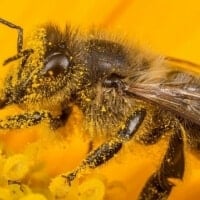Scientists at The University of Western Australia are a step closer to protecting honey bees from a widespread disease that causes dysentery and weakens hives considerably.
In a study published today in the Journal of Proteome, a team at the UWA Centre for Integrative Bee Research (CIBER) investigated how male honey bees responded to an infection with the fungal parasite Nosema apis.
The researchers were able to unravel how sick males mounted a defence against the parasite, identifying several immune molecules. The immune response was also detected in the semen of the males.
Lead author and research fellow Dr Julia Grassl said it was amazing to discover the whole complexity of the insect immune system activated inside the seminal fluid surrounding sperm.
“We already knew that substances in bee semen were able to recognise and kill Nosema apis very efficiently,” Dr Grassl said.
“However, it is surprising how quickly sick males can activate an efficient response to protect their sperm and ultimately the queen against the disease during mating.”
These newest findings of the CIBER team are highly relevant for the Australian beekeeping industry.
On one hand, the identified immune molecules might be developed into a bee-derived medication to heal parasite-infected hives. On the other hand, the study can help breed more disease-tolerant bees in the future.
CIBER is one of the largest bee research facilities in Australia and a global leader in the area of disease research and prevention.
The centre’s research is supported by commercial beekeepers and hobbyists who play a critical part in disease identification and protection of the species.
During the past 20 years there have been dramatic declines in bee populations globally as a result of bee diseases, parasites and exposure of bees to pesticides.
On the other hand, Western Australia has some of the healthiest honey bees in the world due to geographic isolation, biosecurity measures and the banning of pesticide use on hives.

